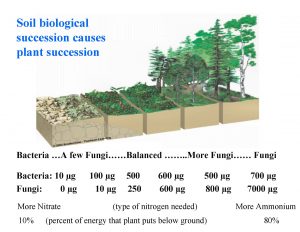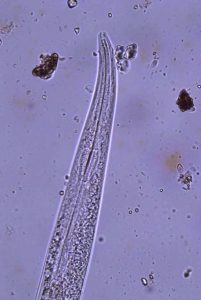Good Soil Biology – The Perfect Recipe For Plants
It’s time to honor our important volunteers who live in the soil – the nematodes, protozoa, microarthropods, fungi and bacteria. All these fellows work tirelessly underground, decomposing organic matter and pooping out the nutrients in the form that plants can use.
In fact, organic matter is the only food we have supplied for the orchard trees and shrubs over the last six years. And, now that we are using the thermal compost process (see Nov. 2017 blog), we will be regularly cooking up tasty treats our plants enjoy.
 Plants put out sugars in their root zones to attract the critters they most desire. Early succession plants, like weeds, desire soil with more bacteria (see Ingham slide). Late succession plants, such as deciduous and conifer trees, prefer fungal dominated soils.
Plants put out sugars in their root zones to attract the critters they most desire. Early succession plants, like weeds, desire soil with more bacteria (see Ingham slide). Late succession plants, such as deciduous and conifer trees, prefer fungal dominated soils.
When we make our compost, the types of inputs we use will determine whether the compost will also be bacterial or fungal dominated.
How do we test the characteristics of our compost? We can put the finished product under the microscope and actually count how many bacteria, fungi, protozoa and nematodes we have and then convert the counts to biomass.
Sun, Jan 21, 2-4, Work Party
Sat, Feb 17, 1-3, Pruning Class
Dr Elaine Ingham offers very accessible online classes in soil biology, making compost, compost tea  and using microscopes to test soil life. She discounts classes at various times of the year. If you take these classes, you will learn how to be a good land steward (see Ingham’s soil food web slide).
and using microscopes to test soil life. She discounts classes at various times of the year. If you take these classes, you will learn how to be a good land steward (see Ingham’s soil food web slide).
You won’t remember but, when seed plants arrived over 360 million years ago, good soil biology was already in place. Plants know what they need from the soil and how to get it. We can all play a part to improve soil quality by minimizing soil compaction and avoiding use of inorganic fertilizers. The importance of soil is the subject of this recent article from the New York Times.
Ruth


I’m stunned to think that composting could ever be suspect! Good job in pointing that out!